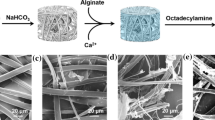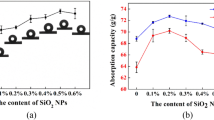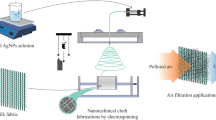Abstract
The rising peril of oil spills, contretemps of oil carriers, and oil seepages polluting our inestimable water bodies and blemishing marine lives are perilous and grievous matters of concern. Silk is one of the utmost appreciated materials for wastewater treatment in arrears to its superhydrophobicity while finding the legitimate solution to the oil spilling problem by offering a safe operating space, considering several such losses due to oil spills. The present study collates oil–water segregation capacities of raw silk, degummed silk, and degummed silk modified with electrospun polylactic acid (DG-Silk/PLA). The oil–water separation capacities of reported samples were assessed by performing a w/w oil absorption capacity test, oil–water separation test, and permeation flux study for petrol, diesel, and engine oil. DG-Silk/PLA showed the maximum oil absorption capacity (petrol ~ 1224%, diesel ~ 1478%, and engine oil ~ 2049%), attributed to its superhydrophobicity (WCA ~ 165 ± 2°) and superoleophilicity (OCA ~ 0°). The optimum oil–water separation was obtained in DG-silk/PLA (76.67–82.57%), followed by the degummed silk and raw silk (RS), respectively. DG-Silk/PLA exhibited enhanced permeation flux for oils than RS and biodegradability than DG-silk. The successive results illustrated that the DG-Silk/PLA could be successfully employed for applied oil–water separation or oil spills cleanup due to their exceptional characteristics.
Graphical abstract


Copyright 2019, Springer Nature










Similar content being viewed by others
Data Availability
All data generated or analyzed during this study are included in the submitted manuscript.
Code availability
Not applicable.
References
Arai T, Freddi G, Innocenti R, Tsukada M (2004) Biodegradation ofBombyx mori silk fibroin fibers and films. J Appl Polym Sci 91:2383–2390. https://doi.org/10.1002/app.13393
Aznar-Cervantes S, Roca MI, Martinez JG et al (2012) Fabrication of conductive electrospun silk fibroin scaffolds by coating with polypyrrole for biomedical applications. Bioelectrochemistry 85:36–43. https://doi.org/10.1016/j.bioelechem.2011.11.008
Babu KM (2019) Developments in the processing and applications of silk. In: Silk. Elsevier, pp 129–142
Badhe Y, Balasubramanian K (2015) Nanoencapsulated core and shell electrospun fibers of resorcinol formaldehyde. Ind Eng Chem Res 54:7614–7622. https://doi.org/10.1021/acs.iecr.5b00929
Balan KK, Sundaramoorthy S (2019) Hydroentangled nonwoven eri silk fibroin scaffold for tissue engineering applications. J Ind Text 48:1291–1309. https://doi.org/10.1177/1528083718763779
Balasubramanian K, Sharma S, Badwe S, Banerjee B (2015) Tailored Non-woven electrospun mesh of poly-ethyleneoxide-keratin for radioactive metal ion sorption. J Green Sci Technol 2:10–19. https://doi.org/10.1166/jgst.2015.1032
Bhalara PD, Balasubramanian K, Banerjee BS (2015) Spider-web textured electrospun composite of graphene for sorption of Hg(II) Ions. Mater Focus 4:154–163. https://doi.org/10.1166/mat.2015.1232
Bittencourt D, Oliveira PF, Prosdocimi F, Rech EL (2012) Review protein families, natural history and biotechnological aspects of spider silk. Genet Mol Res 11:2360–2380. https://doi.org/10.4238/2012.August.13.10
Chen D, Gao H, Jin Z et al (2018) Vacuum-dried synthesis of low-density hydrophobic monolithic bridged silsesquioxane aerogels for oil/water separation: effects of acid catalyst and its excellent flexibility. ACS Appl Nano Mater 1:933–939. https://doi.org/10.1021/acsanm.7b00328
Das A, Dhar M, Manna U (2022) Small molecules derived Tailored-Superhydrophobicity on fibrous and porous Substrates—with superior tolerance. Chem Eng J. https://doi.org/10.1016/j.cej.2021.132597
de Albuquerque TL, Marques Júnior JE, de Queiroz LP et al (2021) Polylactic acid production from biotechnological routes: A review. Int J Biol Macromol 186:933–951. https://doi.org/10.1016/j.ijbiomac.2021.07.074
Etchepare R, Oliveira H, Azevedo A, Rubio J (2017) Separation of emulsified crude oil in saline water by dissolved air flotation with micro and nanobubbles. Sep Purif Technol 186:326–332. https://doi.org/10.1016/j.seppur.2017.06.007
Gore PM, Kandasubramanian B (2018) Heterogeneous wettable cotton based superhydrophobic Janus biofabric engineered with PLA/functionalized-organoclay microfibers for efficient oil-water separation. J Mater Chem A 6:7457–7479. https://doi.org/10.1039/c7ta11260b
Gore PM, Dhanshetty M, K. B, (2016a) Bionic creation of nano-engineered Janus fabric for selective oil/organic solvent absorption. RSC Adv 6:111250–111260. https://doi.org/10.1039/C6RA24106A
Gore PM, Zachariah S, Gupta P, K. B, (2016b) Multifunctional nano-engineered and bio-mimicking smart superhydrophobic reticulated ABS/fumed silica composite thin films with heat-sinking applications. RSC Adv 6:105180–105191. https://doi.org/10.1039/C6RA16781K
Gore PM, Naebe M, Wang X, Kandasubramanian B (2019) Progress in silk materials for integrated water treatments: Fabrication, modification and applications. Chem Eng J 374:437–470. https://doi.org/10.1016/j.cej.2019.05.163
Gore PM, Gawali P, Naebe M et al (2020a) Polycarbonate and activated charcoal-engineered electrospun nanofibers for selective recovery of oil/solvent from oily wastewater. SN Appl Sci 2:1786. https://doi.org/10.1007/s42452-020-03609-x
Gore PM, Naebe M, Wang X, Kandasubramanian B (2020b) Silk fibres exhibiting biodegradability & superhydrophobicity for recovery of petroleum oils from oily wastewater. J Hazard Mater 389:121823. https://doi.org/10.1016/j.jhazmat.2019.121823
Gore PM, Naebe M, Wang X, Kandasubramanian B (2022a) Nano-fluoro dispersion functionalized superhydrophobic degummed & waste silk fabric for sustained recovery of petroleum oils & organic solvents from wastewater. J Hazard Mater 426:127822. https://doi.org/10.1016/j.jhazmat.2021.127822
Gore PM, Sarkar SS, Naebe M et al (2023) Surface functionalized waste-silk fabric engineered with polylactic acid & activated charcoal for oil/solvent recovery from oily wastewater. J Indian Chem Soc. https://doi.org/10.1016/j.jics.2023.101022
Gore PM, Naebe M, Wang X, Kandasubramanian B (2022b) Bioinspired and Natural Materials for Oil/Water Separation. In: ACS Symposium Series. pp 107–123
Gu J, Xiao P, Chen P et al (2017) Functionalization of biodegradable PLA nonwoven fabric as superoleophilic and superhydrophobic material for efficient oil absorption and oil/water separation. ACS Appl Mater Interfaces 9:5968–5973. https://doi.org/10.1021/acsami.6b13547
Gupta P, Kandasubramanian B (2017) Directional fluid gating by janus membranes with heterogeneous wetting properties for selective oil-water separation. ACS Appl Mater Interfaces 9:19102–19113. https://doi.org/10.1021/acsami.7b03313
Gupta VK, Rastogi A, Nayak A (2010) Adsorption studies on the removal of hexavalent chromium from aqueous solution using a low cost fertilizer industry waste material. J Colloid Interface Sci 342:135–141. https://doi.org/10.1016/j.jcis.2009.09.065
Gupta S, Nighojkar A, Mayilswamy N, Kandasubramanian B (2022) Recent trends in the application of silk-based composites for remediation of toxic contaminants from wastewater. J Polym Environ. https://doi.org/10.1007/s10924-022-02741-6
Han D, Currell MJ, Cao G (2016) Deep challenges for China’s war on water pollution. Environ Pollut 218:1222–1233. https://doi.org/10.1016/j.envpol.2016.08.078
Huang Q, Mao F, Han X et al (2014) Migration of emulsified water droplets in petroleum sludge during centrifugation. Energy Fuels 28:4918–4924. https://doi.org/10.1021/ef5008837
Janorkar AV, Metters AT, Hirt DE (2007) Degradation of poly(L-lactide) films under ultraviolet-induced photografting and sterilization conditions. J Appl Polym Sci 106:1042–1047. https://doi.org/10.1002/app.24692
Jauzein V, Colomban P (2009) Types, Structure and Mechanical Properties of Silk. In: Handbook of Tensile Properties of Textile and Technical Fibres. Elsevier, pp 144–178
Jaya Prakash N, Shanmugarajan D, Wang X, Kandasubramanian B (2022) Enhancement of mechano-structural characteristics of silk fibroin using microwave assisted degumming. Sustain Chem Pharm. https://doi.org/10.1016/j.scp.2022.100902
Jaya Prakash N, Sarkar SS, Kandasubramanian B (2023a) Emerging strategies in stimuli-responsive silk architectures. Macromol Biosci. https://doi.org/10.1002/mabi.202200573
Jaya Prakash N, Shanmugarajan D, Kandasubramanian B et al (2023b) Biodegradable silk-curcumin composite for sustained drug release and visual wound monitoring. Mater Today Chem. https://doi.org/10.1016/j.mtchem.2022.101289
Jaya Prakash N, Wang X, Kandasubramanian B (2023c) Regenerated silk fibroin loaded with natural additives: a sustainable approach towards health care. J Biomater Sci Polym Ed. https://doi.org/10.1080/09205063.2023.2170137
Karamanlioglu M, Preziosi R, Robson GD (2017) Abiotic and biotic environmental degradation of the bioplastic polymer poly(lactic acid): a review. Polym Degrad Stab 137:122–130. https://doi.org/10.1016/j.polymdegradstab.2017.01.009
Kaseem M, Ur Rehman Z, Hossain S et al (2021) A review on synthesis, properties, and applications of polylactic acid/silica composites. Polymers (basel) 13:3036. https://doi.org/10.3390/polym13183036
Kim HJ, Kim MK, Lee KH et al (2017) Effect of degumming methods on structural characteristics and properties of regenerated silk. Int J Biol Macromol 104:294–302. https://doi.org/10.1016/j.ijbiomac.2017.06.019
Koh JJ, Lim GJH, Zhou X et al (2019) 3D-printed anti-fouling cellulose mesh for highly efficient oil/water separation applications. ACS Appl Mater Interfaces 11:13787–13795. https://doi.org/10.1021/acsami.9b01753
Liu L, Yuan W (2018) A hierarchical functionalized biodegradable PLA electrospun nanofibrous membrane with superhydrophobicity and antibacterial properties for oil/water separation. New J Chem 42:17615–17624. https://doi.org/10.1039/C8NJ03112F
Liu Y, Xu P, Ge W et al (2021) Synchronous oil/water separation and wastewater treatment on a copper-oxide-coated mesh. RSC Adv 11:17740–17745. https://doi.org/10.1039/d1ra02334a
Ma Q, Cheng H, Fane AG et al (2016) Recent development of advanced materials with special wettability for selective oil/water separation. Small 12:2186–2202. https://doi.org/10.1002/smll.201503685
Malik A, Magisetty R, Kumar V et al (2019) Dielectric and conductivity investigation of polycarbonate-copper phthalocyanine electrospun nonwoven fibres for electrical and electronic application. Polym Technol Mater. https://doi.org/10.1080/25740881.2019.1625390
Mansourizadeh A, Javadi Azad A (2014) Preparation of blend polyethersulfone/cellulose acetate/polyethylene glycol asymmetric membranes for oil-water separation. J Polym Res. https://doi.org/10.1007/s10965-014-0375-x
Mayilswamy N, Jaya Prakash N (2021) Kandasubramanian B (2022) Design and fabrication of biodegradable electrospun nanofibers loaded with biocidal agents. Int J Polym Mater Polym Biomater. https://doi.org/10.1080/00914037.2021905
Milovanovic S, Markovic D, Pantic M et al (2021) Development of advanced floating poly(lactic acid)-based materials for colored wastewater treatment. J Supercrit Fluids 177:105328. https://doi.org/10.1016/j.supflu.2021.105328
Mofokeng JP, Luyt AS, Tábi T, Kovács J (2012) Comparison of injection moulded, natural fibre-reinforced composites with PP and PLA as matrices. J Thermoplast Compos Mater. https://doi.org/10.1177/0892705711423291
Neethu CS, Saravanakumar C, Purvaja R et al (2019) Oil-spill triggered shift in indigenous microbial structure and functional dynamics in different marine environmental matrices. Sci Rep 9:1354. https://doi.org/10.1038/s41598-018-37903-x
Patil NA, Gore PM, Jaya Prakash N et al (2021) Needleless electrospun phytochemicals encapsulated nanofibre based 3-ply biodegradable mask for combating COVID-19 pandemic. Chem Eng J 416:129152. https://doi.org/10.1016/j.cej.2021.129152
Prakash NJ, Mane PP, George SM, Kandasubramanian B (2021) Silk fibroin as an immobilization matrix for sensing applications. ACS Biomater Sci Eng 7:2015–2042. https://doi.org/10.1021/acsbiomaterials.1c00080
Qi X, Ren Y, Wang X (2017a) New advances in the biodegradation of Poly ( lactic ) acid International Biodeterioration & Biodegradation New advances in the biodegradation of Poly ( lactic ) acid. Int Biodeterior Biodegradation 117:215–223
Qi Y, Wang H, Wei K et al (2017b) A Review of structure construction of silk fibroin biomaterials from single structures to multi-level structures. Int J Mol Sci 18:237. https://doi.org/10.3390/ijms18030237
Rastogi S, Kandasubramanian B (2020a) Application of electrospun materials in water treatment. In: Electrospun Materials and Their Allied Applications. Wiley, pp 151–183
Rastogi S, Kandasubramanian B (2020b) Progressive trends in heavy metal ions and dyes adsorption using silk fibroin composites. Environ Sci Pollut Res 27:210–237. https://doi.org/10.1007/s11356-019-07280-7
Rockwood DN, Preda RC, Yücel T et al (2011) Materials fabrication from Bombyx mori silk fibroin. Nat Protoc 6:1612–1631. https://doi.org/10.1038/nprot.2011.379
S. Chopra MG (1994) Comparative evaluation of the various methods of degumming silk. Indian J Fibre Text Res
Safarpour M, Safikhani A, Vatanpour V (2021) Polyvinyl chloride-based membranes: a review on fabrication techniques, applications and future perspectives. Sep Purif Technol. https://doi.org/10.1016/j.seppur.2021.119678
Sahoo BN, Kandasubramanian B (2014) Recent progress in fabrication and characterisation of hierarchical biomimetic superhydrophobic structures. RSC Adv 4:22053. https://doi.org/10.1039/c4ra00506f
Saini H, Otyepková E, Schneemann A et al (2022) Hierarchical porous metal–organic framework materials for efficient oil–water separation. J Mater Chem A 10:2751–2785. https://doi.org/10.1039/D1TA10008D
Sanaeepur H, Ebadi Amooghin A, Bandehali S et al (2019) Polyimides in membrane gas separation: Monomer’s molecular design and structural engineering. Prog Polym Sci 91:80–125. https://doi.org/10.1016/j.progpolymsci.2019.02.001
Simon S, Malik A, Kandasubramanian B (2018) Hierarchical electrospun super-hydrophobic nanocomposites of fluoroelastomer. Mater Focus 7:194–206. https://doi.org/10.1166/mat.2018.1499
Subash A, Naebe M, Wang X, Kandasubramanian B (2023a) Fabrication of biodegradable fibrous systems employing electrospinning technology for effluent treatment. Environ Sci Adv. https://doi.org/10.1039/D2VA00244B
Subash A, Naebe M, Wang X, Kandasubramanian B (2023b) Biopolymer–a sustainable and efficacious material system for effluent removal. J Hazard Mater 443:130168. https://doi.org/10.1016/j.jhazmat.2022.130168
Sun S, Xiao Q-R, Zhou X et al (2018) A bio-based environment-friendly membrane with facile preparation process for oil-water separation. Colloids Surf A Physicochem Eng Asp 559:18–22. https://doi.org/10.1016/j.colsurfa.2018.09.038
Tahalyani J, Rahangdale KK, Aepuru R et al (2016) Dielectric investigation of a conducting fibrous nonwoven porous mat fabricated by a one-step facile electrospinning process. RSC Adv 6:36588–36598. https://doi.org/10.1039/C5RA23012H
Tai MH, Gao P, Tan BYL et al (2014) Highly efficient and flexible electrospun carbon-silica nanofibrous membrane for ultrafast gravity-driven oil-water separation. ACS Appl Mater Interfaces 6:9393–9401. https://doi.org/10.1021/am501758c
Ude AU, Eshkoor RA, Zulkifili R et al (2014) Bombyx mori silk fibre and its composite: a review of contemporary developments. Mater Des 57:298–305. https://doi.org/10.1016/j.matdes.2013.12.052
Wang H, Zhou H, Niu H et al (2015a) Dual-layer superamphiphobic/superhydrophobic-oleophilic nanofibrous membranes with unidirectional oil-transport ability and strengthened oil-water separation performance. Adv Mater Interfaces 2:1400506. https://doi.org/10.1002/admi.201400506
Wang HG, Yuan S, Ma DL et al (2015b) Electrospun materials for lithium and sodium rechargeable batteries: From structure evolution to electrochemical performance. Energy Environ Sci 8:1660–1681
Wang L, Luo Z, Zhang Q et al (2019) Effect of degumming methods on the degradation behavior of silk fibroin biomaterials. Fibers Polym 20:45–50. https://doi.org/10.1007/s12221-019-8658-9
Wang X, Pan Y, Yuan H et al (2020) Simple fabrication of superhydrophobic PLA with honeycomb-like structures for high-efficiency oil-water separation. Chinese Chem Lett 31:365–368. https://doi.org/10.1016/j.cclet.2019.07.044
Wenzel RN (1936) Resistance of solid surfaces to wetting by wateR. Ind Eng Chem 28:988–994. https://doi.org/10.1021/ie50320a024
Wu R, Yu B, Liu X et al (2016) One-pot hydrothermal preparation of graphene sponge for the removal of oils and organic solvents. Appl Surf Sci 362:56–62. https://doi.org/10.1016/j.apsusc.2015.11.215
Wu Z, Li Y, Zhang L et al (2017) Thiol-ene click reaction on cellulose sponge and its application for oil/water separation. RSC Adv 7:20147–20151. https://doi.org/10.1039/C7RA00847C
Xia B, Liu H, Fan Y et al (2017) Novel fabrication of nano functionalized amorphous tungsten oxide coatings with colorful superamphiphobic surface study. Mater Des 135:51–61. https://doi.org/10.1016/j.matdes.2017.08.057
Xie X, Zheng Z, Wang X, Lee Kaplan D (2021) Low-density silk nanofibrous aerogels: fabrication and applications in air filtration and oil/water purification. ACS Nano 15:1048–1058. https://doi.org/10.1021/acsnano.0c07896
Xu X, Zhu X (2004) Treatment of refectory oily wastewater by electro-coagulation process. Chemosphere 56:889–894. https://doi.org/10.1016/j.chemosphere.2004.05.003
Xue Z, Sun Z, Cao Y et al (2013) Superoleophilic and superhydrophobic biodegradable material with porous structures for oil absorption and oil–water separation. RSC Adv 3:23432. https://doi.org/10.1039/c3ra41902a
Xue J, Zhu L, Zhu X et al (2021) Tetradecylamine-MXene functionalized melamine sponge for effective oil/water separation and selective oil adsorption. Sep Purif Technol. https://doi.org/10.1016/j.seppur.2020.118106
Yadav R, Balasubramanian K (2015) Metallization of electrospun PAN nanofibers via electroless gold plating. RSC Adv 5:24990–24996. https://doi.org/10.1039/C5RA03531G
Yan C, Ma S, Ji Z et al (2019) 3D printing of an oil/water mixture separator with in situ demulsification and separation. Polymers (basel). https://doi.org/10.3390/polym11050774
Yeber M, Paul E, Soto C (2012) Chemical and biological treatments to clean oily wastewater: optimization of the photocatalytic process using experimental design. Desalin Water Treat 47:295–299. https://doi.org/10.1080/19443994.2012.696413
Yu Z, Yun FF, Gong Z et al (2017) A novel reusable superhydrophilic NiO/Ni mesh produced by a facile fabrication method for superior oil/water separation. J Mater Chem A 5:10821–10826. https://doi.org/10.1039/C7TA01987D
Zhang Y, Yin M, Lin X et al (2019) Functional nanocomposite aerogels based on nanocrystalline cellulose for selective oil/water separation and antibacterial applications. Chem Eng J 371:306–313. https://doi.org/10.1016/j.cej.2019.04.075
Zhao Y, Sun T, Liao W et al (2019) Amphiphilic graphene aerogel with high oil and water adsorption capacity and high contact area for interface reaction. ACS Appl Mater Interfaces. https://doi.org/10.1021/acsami.9b06506
Zhou H, Wang H, Niu H, Lin T (2018) Recent progress in durable and self-healing super-nonwettable fabrics. Adv Mater Interfaces 5:1800461. https://doi.org/10.1002/admi.201800461
Zhou J, Zhang Y, Yang Y et al (2019) Silk fibroin-graphene oxide functionalized melamine sponge for efficient oil absorption and oil/water separation. Appl Surf Sci 497:143762. https://doi.org/10.1016/j.apsusc.2019.143762
Acknowledgements
The authors would like to thank Dr. C. P. Ramanarayanan, Vice-Chancellor of DIAT (DU), Pune, and Dr. V. K. Saxena, Additional Director of Centre for Converging Technologies, University of Rajasthan, for their support and motivation. The first and second author acknowledges Dr. Amrita Nighojkar, Miss. Niranjana J.P, and Mr. Jigar Patadiya for their unwavering technical support throughout the review writing. The authors are thankful to the editor and the anonymous reviewers who helped to improve the quality of the manuscript with their valuable suggestions and comments.
Funding
The authors did not receive support from any organization for the submitted work.
Author information
Authors and Affiliations
Corresponding author
Ethics declarations
Conflict of interest
The authors declare no conflict of interest.
Ethics approval
The submitted article complies with the ethical guidelines of the journal and does not contain the results of studies involving humans and/or animals.
Consent to participate
Not applicable.
Consent for publication
The authors consent to publish the article on acceptance.
Additional information
Editorial responsibility: Senthil Kumar Ponnusamy.
Rights and permissions
Springer Nature or its licensor (e.g. a society or other partner) holds exclusive rights to this article under a publishing agreement with the author(s) or other rightsholder(s); author self-archiving of the accepted manuscript version of this article is solely governed by the terms of such publishing agreement and applicable law.
About this article
Cite this article
Rastogi, S., Subash, A. & Kandasubramanian, B. Heterogeneous wettable degummed silk fibers engineered with electrospun superhydrophobic PLA for efficacious oil/water separation. Int. J. Environ. Sci. Technol. 21, 3871–3888 (2024). https://doi.org/10.1007/s13762-023-05213-z
Received:
Revised:
Accepted:
Published:
Issue Date:
DOI: https://doi.org/10.1007/s13762-023-05213-z




